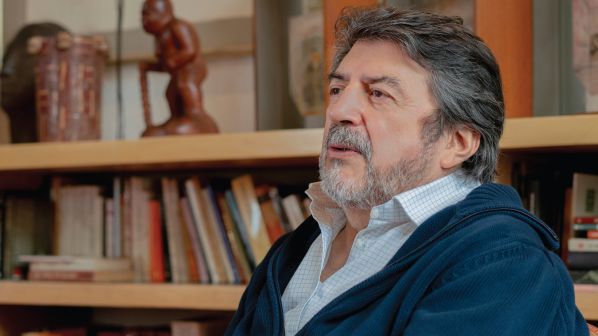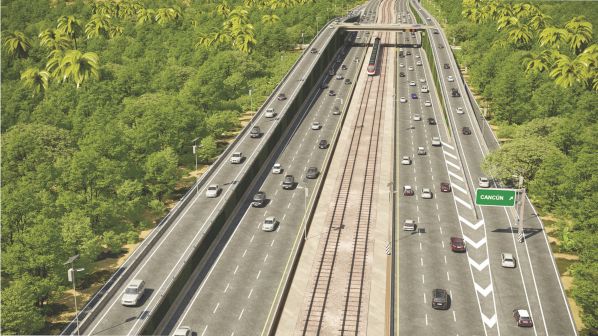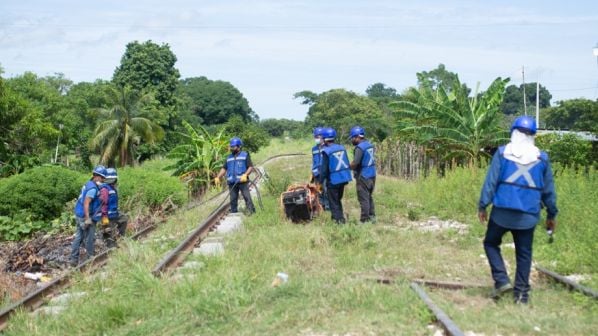THE 1475km Mayan Train project was a campaign promise of Mexican president Mr Andres Manuel Lopez Obrador, ‘Amlo,’ who took office in December 2018. The Pesos 144bn ($US 6.5bn) railway is planned to link historic Mayan sites in five states on the Yucatan peninsula, connecting the rural interior with the buoyant tourist resort cities of Cancun, Playa del Carmen and Tulum on the Caribbean coast.
A native of Tabasco province, Lopez Obrador heralds Mayan Train as a vehicle for creating “hundreds of thousands of jobs” in Mexico’s under-developed southeast. The president has pushed ahead despite criticism, particularly from some indigenous groups, which make up around 20% of Mexico’s population.
The ambitious scheme contrasts with Mexico’s approach to its railway in recent decades. Long-distance passenger services were wound up as the country focused on freight, deeming road connections sufficient for public use.
Such is the break from the recent past, sceptics might be forgiven for feeling that Mayan Train will follow the fortunes of other similarly bold passenger projects over the last few years - Brazil’s project to develop a high-speed line between Rio Janeiro and Sao Paulo, which was cancelled in 2013 springs to mind. As does the more recent Singapore - Kuala Lumpur high-speed project, which may yet happen, but for the moment remains suspended.
Yet Mexico appears to be bucking this trend.
“We are trying to get back to where we were. We need to recover that time by both engaging with companies we have here already and the wider railway industry.”
Rogelio Jiménez Pons, Fonatur tourism board chief
Lopez Obrador waved a flag to mark the start of the project in June 2020, which was followed by the announcement of a flurry of tenders to construct three of the project’s seven stages.
These contracts have now been awarded along with a direct award contract for stage four. Preliminary work on the first four sections is now underway and project developer, the Mexican government’s National Institute for Tourism Promotion (Fonatur), hopes the first train could run as early as 2023.
“Mexico made a big decision around 50 years ago to move away from its railway system and end passenger operation,” Fonatur tourism board chief Mr Rogelio Jiménez Pons, told IRJ. “I remember as a young boy travelling to places by train. We are trying to get back to where we were. We need to recover that time by both engaging with companies we have here already and the wider railway industry. We need those companies to help us to do this project.”
Existing railway
The remnants of Mexico’s railway past are evident in the Mayan Train’s proposed route. Approximately 50% will use existing railway rights-of-way, specifically the former Tehuantepec Istmus Railway between Palenque, Escarcega, and Izamal on the first three sections. The fourth and fifth sections in the north and northeast will use the median of highways while the stretch from Tulum to Chetumal and Escárcega is new line construction. In total the line will have 19 stations and 12 stops, and 40% will be electrified.
The construction contract for the first 227km phase, which runs from Palenque, Chiapas, to Escárcega in Campeche, was awarded to a consortium led by Mota-Engil México at the end of April. The consortium also comprises China Communications Construction Company (CCCC), Cosh Group, Eyasa and Gavil Engineering, and secured the contract with a bid of Pesos 15.5bn. Work on the project commenced shortly after the contract was signed, incorporating coronavirus protection measures to safeguard workers.
The 14 bids received for the tender were analysed by the United Nations Office for Project Services (UNOPS), which found the offer from the consortium represented the best value for money, a process that has been conducted on the first four sections of the route to emphasis the project’s transparency.

The consortium also bid for section 2, the 235km stretch from Escárcega to Calkiní, along with 14 other bidders. The Spanish joint venture of FCC Construcción and Operadora Cicsa ultimately secured the contract with a bid of Pesos 18.55bn. Section three, the 172km stretch from Calkiní to Izamal, was won by a Mexican-Spanish consortium of Construcciones Urales, Gami Ingeniería e Instalaciones and Azvi, Spain, which submitted the winning bid of Pesos 10.19bn.
A Pesos 25bn contract to build section four, the 257km stretch between Izamal and Cancun, was awarded directly to the Ingenieros Civiles Asociados (ICA) consortium, he concessionaire which runs the public-private Mérida - Cancun highway. The developer will incorporate the double-track railway into the median of the six-lane road between Valladolid and Cancun.
“If in 10 years we have grown the traffic, we may then look to a new train and energy contract. Full electrification would only happen if we have met a specific passenger threshold.”
Rogelio Jiménez Pons
The solution cuts the overall length of the line by around 55km and the cost by Pesos 6.5bn compared with the original plan to upgrade the existing line to Valladolid with the new alignment deviating south via Chichén Itza. Jiménez also notes that the chosen solution is the more practical for this element of the project. “It’s the simplest way, since [ICA] has the concession,” Jiménez says. “It has to be directly awarded, taking them out and putting in another company is more complicated.”
The 121km section five between Cancun and Tulum will likewise run in the median of Highway 307. However, plans to award the contract to a consortium led by Blackrock Infrastructure Mexico, which proposed including the railway in its planned update of the road, were declared void in early September due to inconsistencies in the economic proposal.
A new open bidding process is now underway, which is split into two contracts. Both include upgrades to the road as well as construction of the railway and associated electrification. No deadline for bids has yet been confirmed.
With construction getting underway, attention is set to shift this autumn to equipping the railway. A study of demand by PWC identified the need for 80-90 coaches to operate the entire network, particularly to deliver on plans to operate at up to 10-minute frequencies to the west and south of Cancun.

Fonatur is set to commence an international bidding process for a rolling stock supplier to provide a mixed fleet of electric and diesel-electric trains by the end of the year. The developer expects to purchase at least 40 trains with options for additional sets and has a budget of approximately Pesos 40bn.
Fonatur announced on August 6 that just over 40% of the network’s more heavily used sections, comprising 690km between Mérida, on section three, via Cancun to Chetumal on section six, will be electrified from the start of operation. Fonatur will work alongside the Federal Electricity Commission to develop the electrification plan.
“We have enough capacity to meet the demands of the first stage of construction.”
Rogelio Jiménez Pons
Jiménez sees diesel as a more practical solution for sections where traffic is less intensive as the benefits of electrification do not currently justify the cost. He is also intrigued by the prospect of using hydrogen-powered rolling stock. “If in 10 years we have grown the traffic, we may then look to a new train and energy contract,” he says. “Full electrification would only happen if we have met a specific passenger threshold.”
Work on the sixth and seventh construction packages, comprising the respective 254km Tulum - Bacalar - Chetumal and the 287km Bacalar - Escárcega sections, is expected to commence in 2021. This is entirely new line construction and preparatory work is set to be carried out by the Mexican Ministry of Defence (MoD). The MoD has been working on the redevelopment of Mexico City airport and expects to transfer resources to the railway project early next year. Tenders for railway superstructure will be floated separately. The goal is to begin these services in 2024.
“They [the MoD] have proven themselves to be very capable in construction work, and by using them rather than the private sector, we can save 10-20% on the cost of these sections, which is very important for the overall budget,” says Mr Juan Gonzalez, Fonatur’s chief of staff.
Further competitive tendering will take place for operation and maintenance of the railway. Fonatur has invited seven European-based companies to bid for a shadow operator contract. However, plans to award this on October 14 were abandoned after bids did not meet the demands of the tender. Fonatur now plans to directly appoint a shadow operator. The developer will seek a “world-class operator” to offer both stopping services targeting local people and longer distance services for tourists. The line will also carry freight.
Another element of the project, and a significant part of Fonatur’s work, is on developing the area around stations to boost economic development. Gonzalez says an approximate 200-400ha area around each station is earmarked for such projects, which he believes could prove a major boon to Mexico’s southeast, one of the poorest and least developed areas of the country.
This is also emphasised in the potential of the project to boost freight and logistics in the region. Gonzalez says Mexico’s agricultural economy is currently 50% of the international mean, and the southeast is less than 50% of the national mean. In addition, due to poor logistics infrastructure, much of the produce currently grown by local farms in the region is shipped to Mexico City for processing and sale, with many of these goods then shipped back to cities like Cancun for consumption. He hopes the railway will facilitate new logistics flows, ending this scenario and substantially reducing costs.
Domestic industry
As well as promoting general economic development by improving accessibility to the interior, it is hoped the project will spur the growth of a domestic railway industry in Mexico. This could potentially support proposed eastern extensions from Palenque into Tabasco and beyond, again restoring abandoned lines.
“We have enough capacity to meet the demands of the first stage of construction,” Jimenez says. “We have 75-80% of the people that we will need to complete the project. The remaining 20% will come from outside because we are in the development phase of our industry here.”
Development of the peninsula, which is equivalent in size to Britain, has raised concern among some environmental groups. There has been criticism of the possible impact on the Mayan forest’s Calakmul biosphere reserve, one of the most important rainforests in the Americas, through which stage seven of the line will run. The area is also home to many of the protected Mayan archaeological sites which the estimated 7000 tourists who could use the line every day are expected to want to visit.
Fonatur emphasises that the project is in line with UN Habitat’s New Urban Agenda and, as a vehicle for sustainable economic development, would have substantially less environmental impact than an equivalent road scheme. It says that the project requires 14.6km2 of land use change, just 1.13% of the annual loss in the region with Chiapas, Tabasco, Campeche, Yucatan and Quintana Roo losing 23,285km2 of forests in the last 18 years.
The developer has established an environmental advisory board, created a conservancy fund, and introduced environmental damage prevention programmes. The project itself will also incorporate wildlife crossings to reconnect ecosystems, the biggest such programme in Mexican history, and will emphasise sustainable growth at hubs such as Palenque and Escárcega.
Gonzalez says Fonatur and Lopez Obrador have also worked hard to allay the indigenous groups’ concerns. Meetings were held in November and December 2019 attended by more than 10,000 people from 1078 indigenous communities. The project received the unanimous backing of the groups and an agreement was reached to establish a permanent dialogue and participation in the project.
Criticism
Gonzalez notes that much of the criticism has been expressed by groups residing away from the railway, including the Zapatistas. Generally, he says those who live close by are now in favour of the project and the benefits that the associated economic schemes will bring, among them a new aqueduct which will help to ease the chronic water shortage in the region.
“We have found that we have support for the project from these groups because for the first time they can see that the government is doing something that will help and support them,” he says.
Nevertheless, the project continues to work against the backdrop of the possibility of corruption and the challenges of delivering a difficult programme of work in Mexico, which has a mixed track record of major project success.
In its assessment of the project, British-based Falanx Assynt, a global intelligence consultancy and provider of geopolitical, strategic and business risk analysis, notes that the size of the project and its extremely short timescale make delays highly likely. In addition, the report says firms involved may face direct presidential criticism and intense scrutiny from the media and activists.
“The size of the contracts involved, and the lack of competitive bidding for some parts of the work, suggest that corruption will be a major threat, as it is for all large-scale state-funded construction and procurement projects in Mexico,” the report says.
Gonzalez is quick to emphasise Fonatur’s openness and transparency regarding Mayan Train. He says this approach is intended to shed the idea that corruption continues to persist. “There is a commitment from this government to break from the past and show this is no longer the situation in Mexico,” he says.
As a politically charged project there is also the chance that a change in leadership at the head of government could derail the scheme.
The next presidential election is scheduled for 2024 and Lopez Obrador has vowed not to seek a second term, choosing instead to return to his ranch in southern Mexico. However, by this stage, the hope is that the Mayan Train will be operational.
The project’s leap from drawing board and political pipedream to the start of construction certainly caught the wider railway industry’s attention in recent months. And while the impact of the coronavirus pandemic on progress is difficult to quantify at this stage, there is optimism at Fonatur that Mayan Train will sustain this early momentum.

